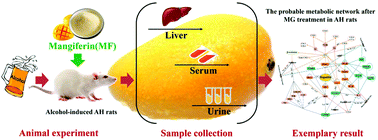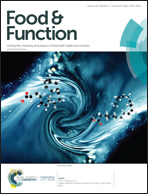Mangiferin improves hepatic damage-associated molecular patterns, lipid metabolic disorder and mitochondrial dysfunction in alcohol hepatitis rats†
Abstract
This study was conducted to investigate the beneficial effects and possible mechanism of action of mangiferin (MF) in alcohol hepatitis (AH) rats. Building on our previous study, the damage-associated molecular patterns (DAMPs), lipid metabolic disorder and mitochondrial dysfunction were investigated. MF effectively regulated the abnormal liver function, the levels of alcohol, FFAs and metal elements in serum. More importantly, MF improved the expression levels of mRNA and protein of PPAR-γ, OPA-1, Cav-1, EB1, NF-κB p65, NLRP3, Cas-1 and IL-1β, and decreased the positive protein expression rates of HSP90, HMGB1, SYK, CCL20, C-CAS-3, C-PARP and STARD1. Additionally, MF decreased the levels of fumarate, cAMP, xanthurenic acid and D-glucurone-6,3-lactone, and increased the levels of hippuric acid and phenylacetylglycine, and then adjusted the changes of phenylalanine metabolism, TCA cycle and ascorbate and aldarate metabolic pathways. The above results suggested that MF can effectively prevent AH by modulating specific AH-associated genes, potential biomarkers and metabolic pathways in AH rats, etc.



 Please wait while we load your content...
Please wait while we load your content...